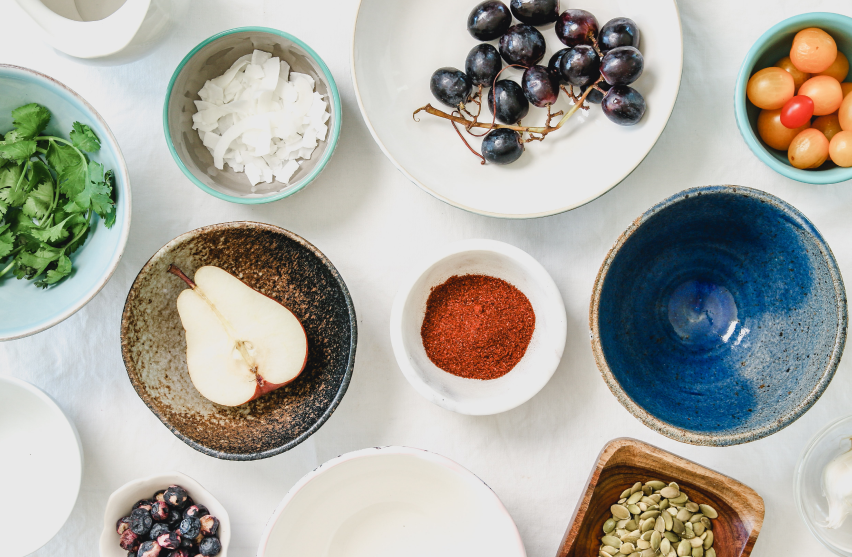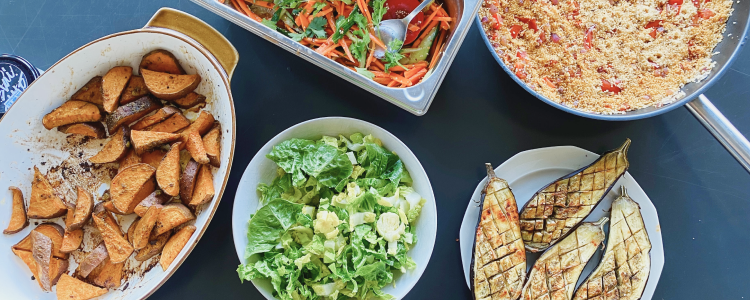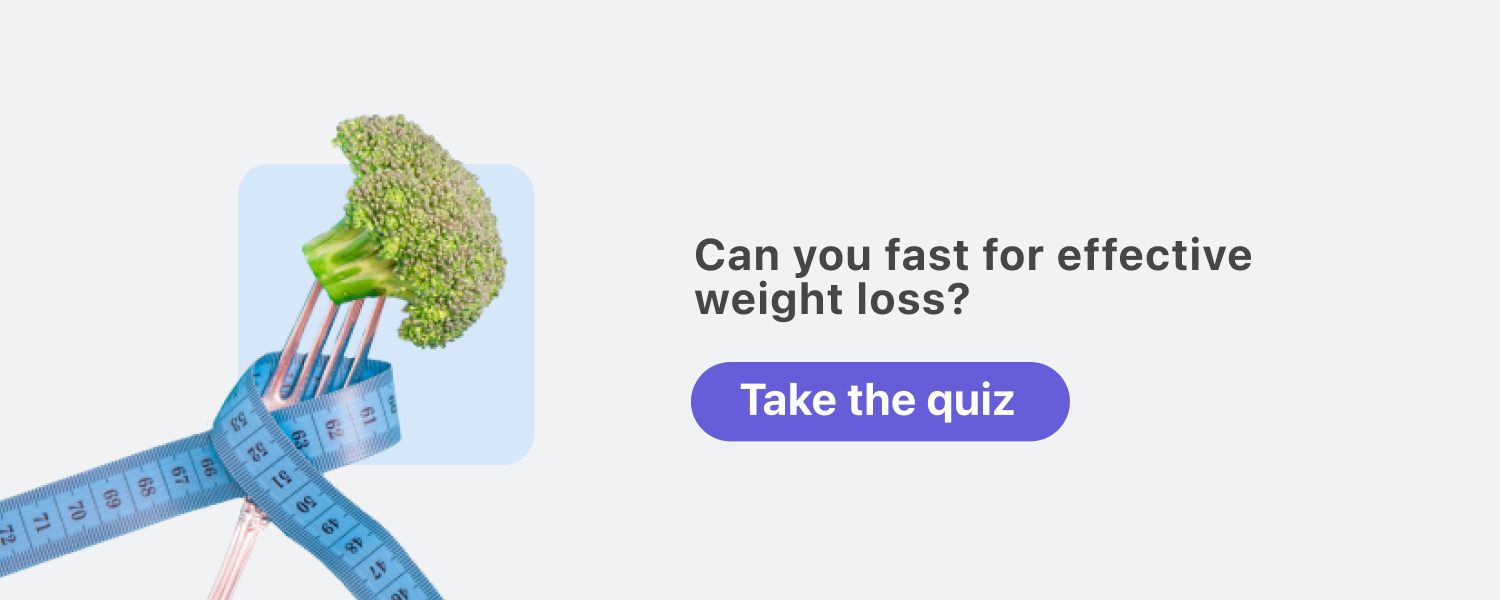The flexitarian diet — a beginner’s guide by Simple

From workouts to working hours, most of us enjoy a little flexibility. So it’s no wonder that when it comes to what we eat, a little wiggle room goes a long way.
A flexitarian diet (think “flexible” + “vegetarian”) is a food routine that involves eating primarily plant-based foods but still accommodates occasionally eating meat and other animal products in moderation. Less limited than purely vegetarian or vegan eating habits while still introducing many of the benefits of a plant-based diet, the flexitarian diet is not only a potential way to improve overall health (yours and our planet’s!) but also to avoid strict rules and calorie counting.

Whether you’re looking to cut down on your meat consumption or just want to learn more about what the U.S. News & World Report ranks as the second-best overall food routine for long-term health and disease prevention, we’ve got you covered. In this guide, our experts explain what a flexitarian diet looks like, how it works, and why it might be a good fit for you.

What is the flexitarian diet?
Probably the easiest way to answer the question of “What is a flexitarian diet?” is to understand what it’s not.
A flexitarian food routine is not a rigid eating plan with strict rules about what you can eat or when you can eat. No foods are off-limits, and there aren’t even set guidelines about how much you should eat. Flexitarian eating habits simply prioritize produce, plant-based protein, and nondairy, calcium-fortified alternatives and reduce the amount of meat, fish, chicken, and other poultry on your plate. How many meals or days you’re meat-free is entirely up to you and your goals / preferences.
It’s also not a food routine driven by one specific purpose. Some people follow it to reduce their meat consumption, others consider it for weight loss, and others try it out as a way to boost overall health, promote a longer life, or eat more nutrient-dense foods.
So whether you’re thinking about becoming a flexitarian in support of a specific health goal or just want to incorporate more health-promoting foods into your meals, this veggie-forward approach to eating may help.
How does the flexitarian diet work?

What’s one reason most of us prefer flexibility over rigid routines? It’s easier.
Rather than bending over backwards — even if we’re fully capable, literally or metaphorically — we’d rather stretch and figure out what practice works best for us at that moment.
The flexitarian diet is the food routine equivalent of that. Rather than forcing you to bend to its whims, it can be built around your unique body, goals, and preferences. It simply involves basing your eating habits around the following principles:
- eating mostly fruits, vegetables, legumes, and whole grains;
- focusing on plant-based protein over animal-based protein;
- incorporating meat and animal products, but not for every meal; and
- prioritizing nutrient-dense, natural forms of food over ultra-processed ones.
There’s no set or “right” amount of meals or days you have to go without meat or animal products, either. Maybe you start with a few meatless meals per week or one meatless day and work your way up to more. Maybe you’re already used to some meat-free meals, so you want to go fully vegetarian every other day.
You get to choose your own regimen, your own pace, and how far you want to take it. The flexitarian world is your (sustainably sourced, ideally plant-based somehow) oyster.
Since the flexitarian diet is so adaptable, it can also complement other eating routines. For example, if you’re a fan of intermittent fasting, you can follow flexitarian principles for your eating windows. However, since you’ll be eating plant-forward meals, you also need to ensure you’re planning meals that will still give you all the protein and other nutrients your body needs.
Particularly if you’re thinking of becoming a flexitarian to help you reach your happy weight, we can help. You can kick off learning more about health-promoting eating and nutrition habits with our Simple quiz.
The flexitarian diet meal plan
With no strict food limits or eating windows to manage, no set macros or calories to consider, and no hard-to-find specialty ingredients to source, a flexitarian diet plan can be a breeze to cater to — at least in theory.
In practice, though, a flexitarian meal plan requires some careful and intentional decisions to ensure your recipes and meals are giving you everything your body needs to feel its best (especially protein and certain vitamins and minerals, since you may miss out on those when you cut back on meat and animal products).
So “plan” may be a loose fit for what the adaptable, customizable flexitarian food routine involves, but you will need to factor planning into your food choices. While living off pasta and garlic bread may sound delicious and plant-forward, sadly, carbs alone are not enough to fuel all the different parts and processes of our bodies.
Our experts have put together some general advice on how to meal plan, but when it comes to a flexitarian diet meal plan, here are some ideas about what to prioritize, what to limit, and how to balance it all on your plate.
Foods to eat on the flexitarian diet
- fruits
- vegetables
- whole grains (like quinoa, oats, and brown rice)
- plant proteins (like beans, lentils, chickpeas, and tofu)
- healthy fats (like avocados, nuts, and nut butters)
- plant-based, vitamin- and mineral-fortified milk alternatives (dairy milk products are fine in moderation)
Foods to limit on the flexitarian diet
- meat and poultry
- fish
- ultra-processed foods (like cookies, chips, and fast food)
- foods high in sugar (like candy, cakes, and desserts)
- foods high in sodium (like cured meats, pizza, and fried food)
Health benefits and risks of the flexitarian diet

If you’re already on board with the concept of flexitarianism, you’ll love what we have to say next: flexitarian diets are associated with several major potential benefits,[1] including decreasing greenhouse gas emissions, but not many potential risks.[2]
Before we dive into the science of it all, one important thing to keep in mind when it comes to flexitarianism is that, by definition, there isn’t one clear, universal approach to this food routine, and there are a lot of ways you can be flexitarian.[3] That means it’s difficult for researchers to show definitively or precisely how this way of eating compares to other plant-heavy meal plans, if there are certain levels of flexitarianism that yield better benefits, and how other lifestyle factors — like age, existing medical conditions, and physical activity levels — might impact results. Likewise, a lot of existing research focuses on fully vegetarian or vegan eating habits, so it’s unclear if these benefits and risks are still fully applicable to flexitarianism.
Health benefits of the flexitarian diet
Better heart health
Eating more fiber, healthy fats, and plant-based foods has been linked to overall better heart health,[4] lower cardiovascular risk factors (like hypertension and high cholesterol),[5] and reduced instances of coronary heart disease.[6]
Lower risk of insulin resistance and type 2 diabetes
Plant-based eating routines have been linked to a substantially reduced risk of developing type 2 diabetes [7] and (at least for people who already have type 2 diabetes) improved blood sugar control.[8]
Lower risk of certain cancers
Some studies have also correlated plant-based diets to reduced instances of cancer,[9] especially colorectal cancers.[10] One longitudinal study also found that eating limited amounts of meat or fish is associated with a lower risk of cancer when compared to regular meat and fish eaters.[11]
Improved skin health
Plant-based foods are packed with stuff your skin loves, like vitamins C and E, beta carotene (the precursor to retinol), and polyphenols (powerful antioxidants). These nutrients can support skin elasticity, reduce inflammation, and enhance the skin’s protective barrier.[12]
Health risks of the flexitarian diet
Potential nutrient deficiencies
Although most plant and plant-based foods are naturally health-promoting, they aren’t a magic source of all vitamin and mineral requirements, so relying more on them means careful planning to ensure you aren’t accidentally ending up in a deficit when it comes to certain nutrients.[13] Some of the main nutrients to watch out for are vitamin B12 (which only occurs naturally in animal products), iron and zinc (which we absorb better from animal foods), omega-3 fatty acids (which are most prevalent in fatty fish), and calcium (which is naturally high in dairy products).
Exacerbated IBS or digestive issues
In people who have IBS or experience certain digestive issues, some dietary fibers found naturally in plant-based foods may trigger or aggravate bloating and stomach pain.[14]
Pros and cons of the flexitarian diet
| Pros | Cons |
| Budget friendly | Lacks specific step-by-step structure |
| Mixes with other food routines | Can cause certain nutrient deficiencies |
| Flexible and adaptable | Requires mindful meal planning |
| Plenty of options for recipes | |
| Straightforward in concept |
Pros
A flexitarian food routine is basically a yoga guru combined with a professional ballet dancer: it’s one of the most malleable and flexible routines out there. Guided just by a series of principles rather than finite requirements, it’s both simple to follow and easily customizable to your unique needs. It also layers well with other food routines, so if you or your family are already following kosher, halal, gluten-free, low-fat, or other meal plans, you can likely build flexitarianism safely on top.
Possibly the best perk, though, is that you have virtually endless choices in what to eat — no foods are off the table entirely, and flexitarian staples like produce, beans, and whole grains are easily and cheaply accessible from your local grocery store.
Cons
Sometimes too much choice can be overwhelming, and while flexibility in recipes and meal times is usually a good thing, the lack of step-by-step guidance can be stressful if you’re not sure where or how to start and what plant-based recipes might work for you (especially if you have any picky eaters in the house or aren’t used to eating plant-forward meals).
Without intentionally planning your meals for the week, you also may not get your fill of the nutrients your body needs, and over time, these deficiencies could lead to other health problems.
Is the flexitarian diet right for you?
Although a flexitarian diet may be particularly helpful for people who have a family history of heart disease or are at risk of developing type 2 diabetes, anyone can benefit from its health-boosting effects.
As with any new eating routine, before you make any substantial modifications, you may want to talk to your doctor. A dietitian — or our Simple quiz! — may also be a helpful starting point for figuring out a meal plan that might best support your body.

The flexitarian diet and weight loss
Given its focus on nutrient-dense, health-promoting foods and the limiting of foods high in sugar, salt, and saturated fat, a flexitarian food routine may help you reach or maintain your happy weight, even if that’s not its primary goal.
Since everybody responds to eating patterns differently, flexitarian weight loss results can vary, and flexitarian diet weight loss isn’t necessarily guaranteed. Likewise, some benefits — specifically decreased levels of fat — may be more connected to fully vegetarian or fully vegan diets.[15] And when it comes to shedding pounds, it’s important to remember fat loss vs. weight loss are two different things, and the question of how to burn fat is a more relevant ask than how to lose weight when it comes to improving your health. A number on a scale is just a number, not a sign.
However, broadly speaking, plant-focused food routines have been linked to more significant weight loss,[16] a lower BMI,[1] reduced waist circumference,[17] and more short-term weight loss than non-plant-focused food routines.[18]
In order to understand both the short-term and long-term effects of the flexitarian food routine on weight management when compared to other diets, though, more research is needed.
Since the flexitarian diet can be followed so differently by different people — and everybody’s different in how their body may respond — it’s difficult to say if you’ll lose weight on the flexitarian diet or how much you might lose. However, plant-forward diets have been linked to lower BMI, reduced waist circumference, and more overall weight loss than non-plant-based food routines.
Flexitarians can eat anything for breakfast: nothing’s off-limits, though we don’t recommend gorging on donuts and pastries every day! Nutrient-dense, primarily plant-based foods like the following are a great place to start:
- whole grains like oats and good quality bread (we love a rye sourdough!)
- fruits
- tea or coffee
- peanut butter or nut butter
- avocado (on whole wheat or whole grain toast)
- eggs (an omelet or frittata could be a great way to work in veggies, too)
- fortified milk or yogurt alternatives
Yes, you can have coffee on a flexitarian diet. In spite of being such a naturally bitter drink, coffee in certain amounts and circumstances may actually have some pretty sweet health benefits.[19] However, if you’re not an Americano drinker, you may want to skip the creamer and artificial sweeteners and opt for a calcium-fortified plant-based milk instead.
To get enough protein on a flexitarian diet, you want to prioritize plant-based protein, especially on days you’re limiting or not eating animal protein. There are lots of good options out there, but some of our favorites include:
- legumes
- beans
- lentils
- tofu
- tempeh
- seitan
- quinoa
- wild rice
- nuts, seeds, and nut butters
- higher protein veggies like broccoli, spinach, and sweet potatoes

- Derbyshire EJ. Flexitarian diets and health: A review of the evidence-based literature. Front Nutr. 2016;3:55.
- Aleksandrowicz L, Green R, Joy EJM, Smith P, Haines A. The impacts of dietary change on greenhouse gas emissions, land use, water use, and health: A systematic review. PLoS One. 2016 Nov 3;11(11):e0165797.
- Dagevos H. Finding flexitarians: Current studies on meat eaters and meat reducers. Trends Food Sci Technol. 2021 Aug 1;114:530–9.
- Hu FB. Plant-based foods and prevention of cardiovascular disease: An overview. Am J Clin Nutr. 2003 Sep;78(3 Suppl):544S – 551S.
- Wozniak H, Larpin C, de Mestral C, Guessous I, Reny JL, Stringhini S. Vegetarian, pescatarian and flexitarian diets: sociodemographic determinants and association with cardiovascular risk factors in a Swiss urban population. Br J Nutr. 2020 Oct 28;124(8):844–52.
- Tong TYN, Appleby PN, Bradbury KE, Perez-Cornago A, Travis RC, Clarke R, et al. Risks of ischaemic heart disease and stroke in meat eaters, fish eaters, and vegetarians over 18 years of follow-up: results from the prospective EPIC-Oxford study. BMJ. 2019 Sep 4;366:l4897.
- Satija A, Bhupathiraju SN, Rimm EB, Spiegelman D, Chiuve SE, Borgi L, et al. Plant-based dietary patterns and incidence of type 2 diabetes in US men and women: Results from three prospective cohort studies. PLoS Med. 2016 Jun;13(6):e1002039.
- Yokoyama Y, Barnard ND, Levin SM, Watanabe M. Vegetarian diets and glycemic control in diabetes: a systematic review and meta-analysis. Cardiovasc Diagn Ther. 2014 Oct;4(5):373–82.
- Dinu M, Abbate R, Gensini GF, Casini A, Sofi F. Vegetarian, vegan diets and multiple health outcomes: A systematic review with meta-analysis of observational studies. Crit Rev Food Sci Nutr. 2017 Nov 22;57(17):3640–9.
- Orlich MJ, Singh PN, Sabaté J, Fan J, Sveen L, Bennett H, et al. Vegetarian dietary patterns and the risk of colorectal cancers. JAMA Intern Med. 2015 May;175(5):767–76.
- Watling CZ, Schmidt JA, Dunneram Y, Tong TYN, Kelly RK, Knuppel A, et al. Risk of cancer in regular and low meat-eaters, fish-eaters, and vegetarians: A prospective analysis of UK Biobank participants. BMC Med. 2022 Feb 24;20(1):73.
- Fam VW, Charoenwoodhipong P, Sivamani RK, Holt RR, Keen CL, Hackman RM. Plant-based foods for skin health: A narrative review. J Acad Nutr Diet. 2022 Mar;122(3):614–29.
- García Maldonado E, Gallego-Narbón A, Vaquero MaP. Are vegetarian diets nutritionally adequate? A revision of the scientific evidence. Nutr Hosp. 2019 Aug 26;36(4):950–61.
- El-Salhy M, Ystad SO, Mazzawi T, Gundersen D. Dietary fiber in irritable bowel syndrome (Review). Int J Mol Med. 2017 Sep;40(3):607–13.
- Turner-McGrievy GM, Davidson CR, Wingard EE, Wilcox S, Frongillo EA. Comparative effectiveness of plant-based diets for weight loss: a randomized controlled trial of five different diets. Nutrition. 2015 Feb;31(2):350–8.
- Huang RY, Huang CC, Hu FB, Chavarro JE. Vegetarian diets and weight reduction: A meta-analysis of randomized controlled trials. J Gen Intern Med. 2016 Jan;31(1):109–16.
- Ferguson JJ, Oldmeadow C, Mishra GD, Garg ML. Plant-based dietary patterns are associated with lower body weight, BMI and waist circumference in older Australian women. Public Health Nutr. 2022 Jan;25(1):18–31.
- Brown L, Rose K, Campbell A. Healthy plant-based diets and their short-term effects on weight loss, nutrient intake and serum cholesterol levels. Nutr Bull. 2022 Jun;47(2):199–207.
- Poole R, Kennedy OJ, Roderick P, Fallowfield JA, Hayes PC, Parkes J. Coffee consumption and health: umbrella review of meta-analyses of multiple health outcomes. BMJ. 2017 Nov 22;359:j5024.
